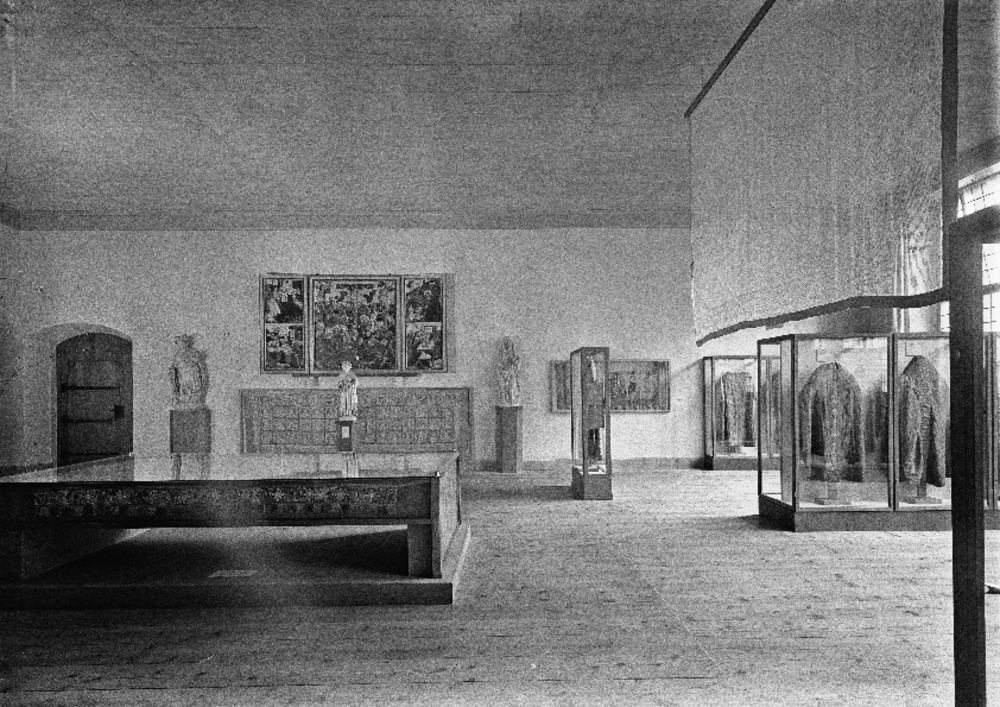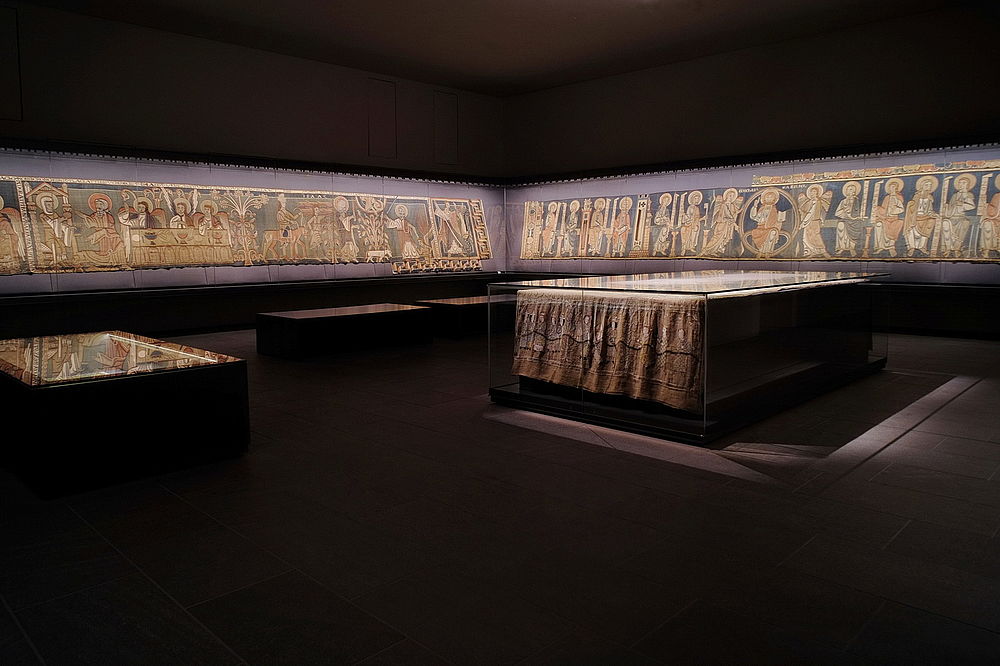The cathedral treasures
One of the world’s most highly renowned church treasures, Halberstadt Cathedral treasures present some peerless works of art. These include the oldest 12th-century tapestries, or Byzantine textiles and goldwork. Precious manuscripts from the early to late Middle Ages still bear witness to religious life at Halberstadt Cathedral. Robes made of gold and silk reveal the elaborate clothing of the bishops and canons, while costly vessels decorated with filigree, enamel and jewels illustrate the ceremonious church services with their display of riches and relics. Serene and august, yet dramatically expressive, the altarpieces and sculptures from the 13th to 16th centuries convey an impression of how present the saints and the Bible stories were in the mediaeval world of faith.
These extensive holdings are exhibited in their historical rooms in the treasury and the cathedral cloister. They offer a vivid insight into the arts and crafts of the Middle Ages and into a thousand-year-old tradition of Christian life in Halberstadt.
Experience a panoramic tour of the treasury, created by erlebnisland.de and sponsored by Saxony-Anhalt’s tourism association, LTV.
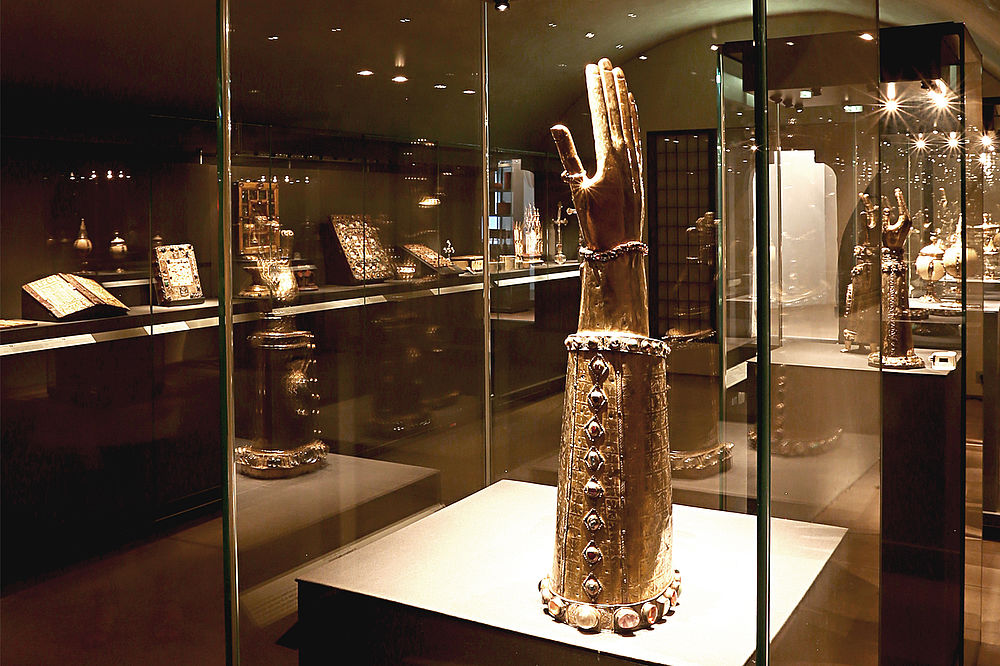
The cathedral treasures in the Middle Ages
The history and holdings of the cathedral treasures go back to the time the diocese was founded, in the 9th century. It was not, after all, only in today’s Gothic cathedral that the clergy held their services; all the previous buildings also contained not just a main altar but also numerous other altars. To lead the service they required vestments, missal books and sacred vessels for mass, and on special feast days they decorated the church interior with enormous tapestries. Evidence of this is provided in the form of manuscripts which have survived to this day, such as an evangelistary from the 2nd quarter of the 9th century, bishop’s vestments or the huge 12th-century tapestries.
The furnishings were donated not only by the Halberstadt canons themselves, but also by friends of Halberstadt Cathedral: bishops, nobles and emperors who donated treasures on their visits. In the Middle Ages, relics – saints’ body parts or objects belonging to them – were the most highly valued as remnants attesting to their healing powers. As early as the 10th century, Bishop Bernhard brought important relics from Rome to Halberstadt, including body parts belonging to St. Sixtus. Ever since, Sixtus has been the cathedral’s second patron saint, alongside Stephen.
The gift from Bishop Konrad von Krosigk was considered even more valuable, however. In 1204, he took part in the Fourth Crusade, which culminated in the Sack of Constantinople. The treasures he brought back included unequalled relics such as parts of Christ’s cross and crown of thorns or of Mary’s hair and robe, as well as relics from numerous saints and martyrs of the Eastern Church. Krosigk also donated sacred vessels and embroidered silk fabrics. He also donated or commissioned containers for the relics, meaning that alongside the Byzantine works, numerous works of art from the Halberstadt region found their way into the cathedral treasures in the course of the 13th century.
This constantly growing trove of spiritual and material treasures was given a worthy setting when today's Gothic cathedral was built (1236/39–1486/91). The pieces either stood right by the many altars or in the “upper and lower sanctuary”, i.e. parts of the sacristy – where they are still presented today. In the first quarter of the 16th century, a new, iron-clad container was placed on the high altar. This reliquary shrine was where the canons kept the relics safe from thieves, and displayed them on certain feast days.
In the first half of the 16th century, the canons completed most of the furnishings for the altars and services.
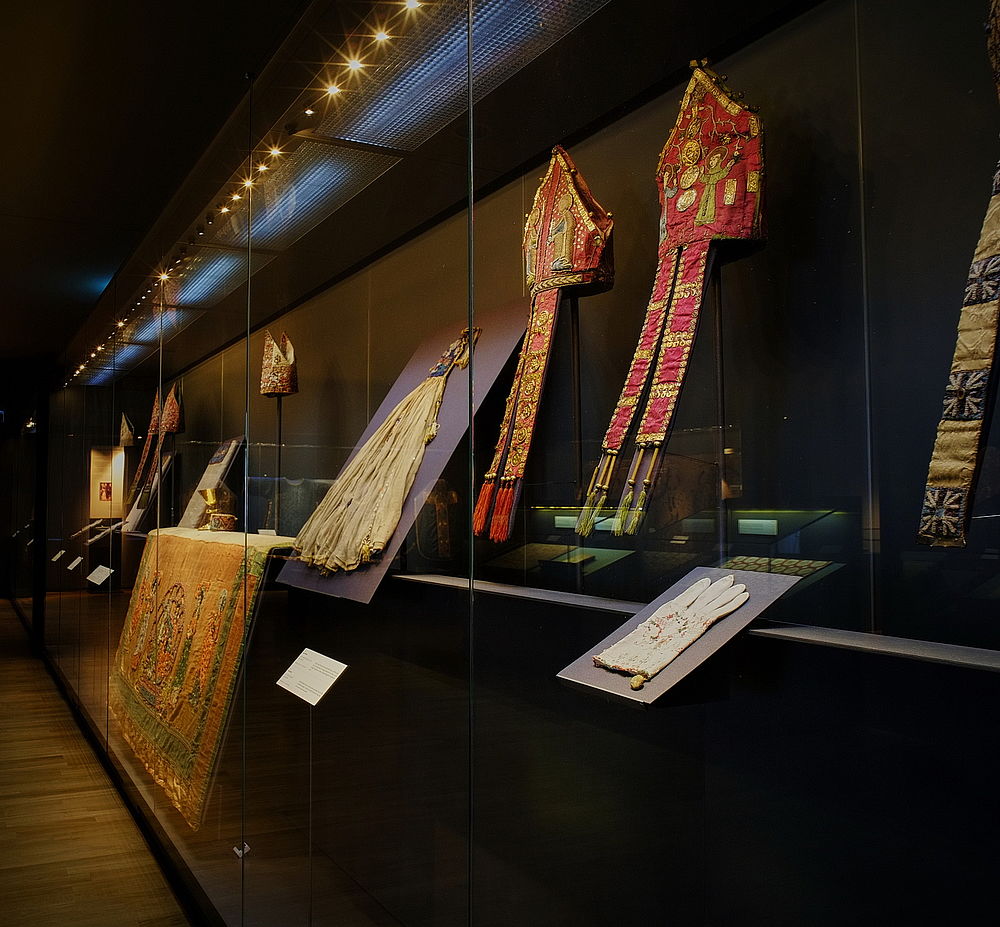
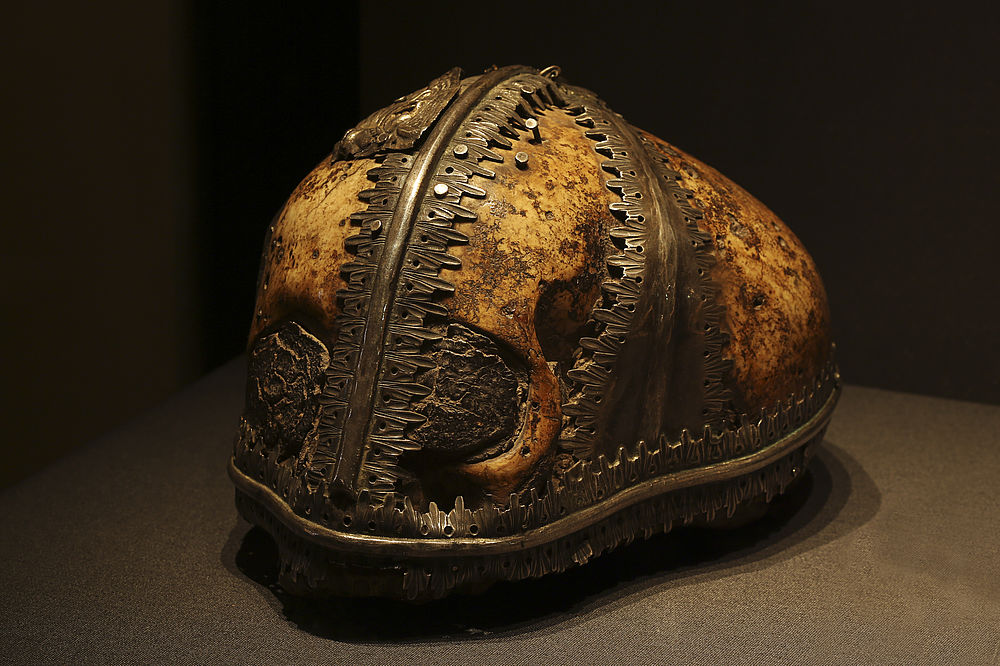
The cathedral treasures from the 16th to the 19th centuries
In 1591, the Halberstadt bishop Heinrich Julius von Braunschweig introduced the Reformation at the cathedral. However, not all the canons took on the Protestant faith; four remained Catholic and continued to live according to that faith. The Protestant canons respected the furnishings (vestments, sacred vessels and reliquaries) used by their Catholic brothers in faith. Protestants and Catholics celebrated different services and masses, but agreed to share the same canonical hours. As a result, the cathedral treasures remained in active use during services, so were not destroyed or sold in any large numbers. The mixed cathedral chapter continued to lead ecumenical life until secularisation in 1810.
In 1810, when the church and state were separated, the cathedral chapter was dissolved, church property was confiscated, and the cathedral was turned into a parish church. Faced with the imminent threat of the works in the cathedral treasures also being sold, the cathedral’s preachers argued that the cathedral and its treasures were an important piece of cultural history, but were only of low financial value. They were successful.
Even during the 18th century, the cathedral treasures were already starting to be valued less in their role as items of religious veneration and more as sights of cultural and historical interest. Accordingly, in the 19th century, increasing numbers of pieces from the cathedral treasures began to be displayed in the cathedral outbuildings, the chapter house and the treasury, to make them as convenient to view as possible.
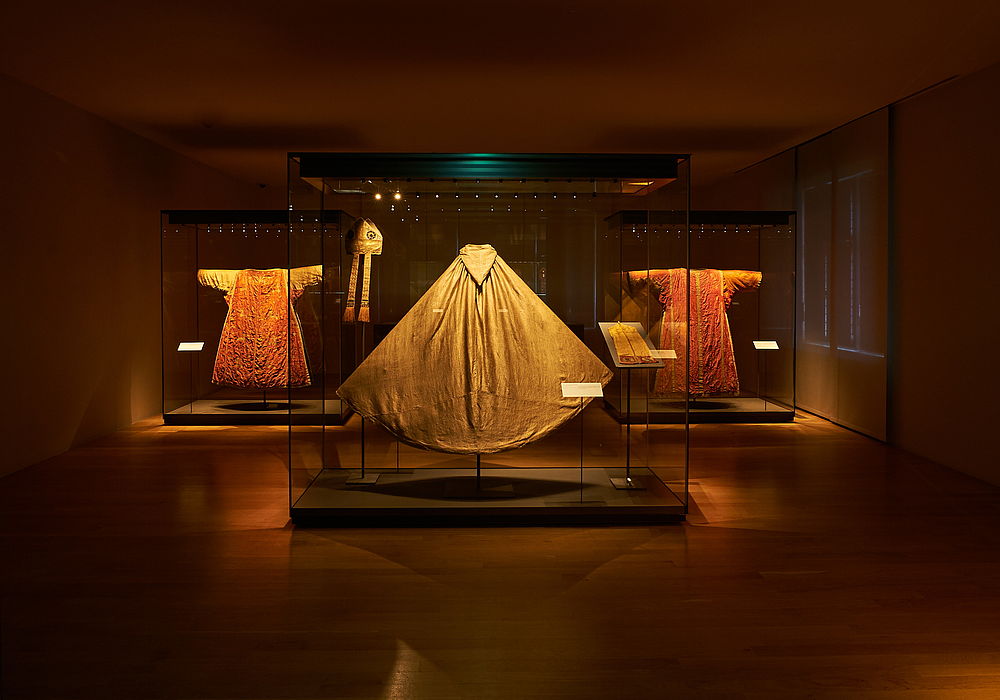
The cathedral treasures in the 20th century
Eventually, in 1936, the “Cathedral Museum” exhibition opened. Religious vestments were shown in the west wing and works of art and sculpture in the upper chapter house. From the very beginnings, and to this day, the particularly valuable treasures have always been displayed in the historical treasury.
Just a few years later, the cathedral treasures had to close again for the Second World War. In 1941, the works of art began to be stored elsewhere, ending up in 1944 in the “Altenburg Cave” near Quedlinburg. After the American advance into Germany, their location put them in danger. When the Quedlinburg Abbey treasures were stolen from the front part of the same cave, the mayor there sent an urgent warning to Halberstadt, asking for the cathedral treasures to be fetched from Quedlinburg “as soon as possible”: “We have given up on this place of safekeeping as too much has been stolen by the ‘guards’”. In an adventurous rescue operation involving a hearse, the treasures were then relocated. They survived the Second World War almost intact.
After the cathedral had been rebuilt in 1956, the exhibition was reopened. The exhibits continued to be divided among the west wing, the chapter house and the treasury, and the Romanesque tapestries from the cathedral were also added. From 1959 to 2006, plenty of curious visitors explored the cathedral treasures on guided tours.
After German reunification, the cultural foundation Kulturstiftung Sachsen-Anhalt took ownership of the cathedral (in 1996) and the cathedral treasure (in 1998). Along with the Saxony-Anhalt State Office for Heritage Management and Archaeology and Halberstadt’s Protestant church community, they developed a new concept for conserving and presenting the cathedral treasures. To this end, they selected some 300 items of treasure for a modern permanent exhibition, and also build a new museum extension, which the then German President Prof. Dr. Horst Köhler officially opened in 2008. In 2020, Kulturstiftung Sachsen‑Anhalt took over from Halberstadt’s Protestant church community in running the cathedral treasures, following the shared aim of safeguarding its treasures and making them known to a broad audience.
